| Author |
Message |
Brian Boll

|
 Posted: Mon 09 Apr, 2007 7:27 pm Post subject: Longsword Pommel Gripping Posted: Mon 09 Apr, 2007 7:27 pm Post subject: Longsword Pommel Gripping |
 |
|
Despite the relative prevalence of tapered scent-stopper pommels on medieval longswords, I happen to be rather partial to the wheel form. Many tout the benefits of the scent-stopper, including its purported quality of acting as an extension of the grip. However, it seems to me that wheel pommels are not entirely useless in such a fashion, and, in fact, I find them rather comfortable when gripped. I must ask, however, if there is any consensus or precedent dictating how precisely one ought to grip a wheel pommel on a longsword, or if it is entirely personal preference (as, it would seem, is whether or not to grip the pommel at all). I list here three variations; there may be others:
 Attachment: 77.38 KB Attachment: 77.38 KB
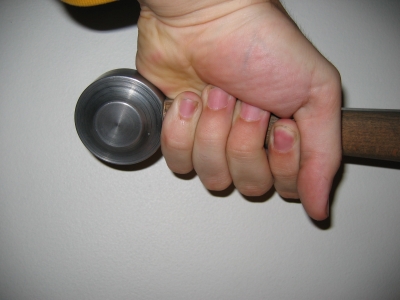
 Attachment: 81.78 KB Attachment: 81.78 KB
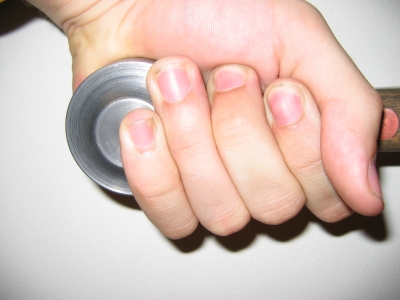
 Attachment: 61.99 KB Attachment: 61.99 KB
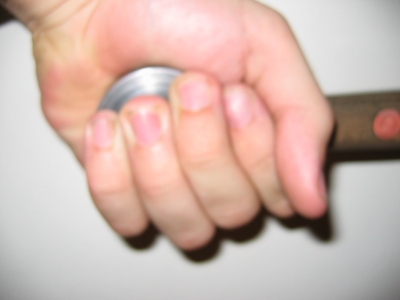
|
|
  |
 |
|
Matthew K. Shea
|
 Posted: Mon 09 Apr, 2007 8:33 pm Post subject: Posted: Mon 09 Apr, 2007 8:33 pm Post subject: |
 |
|
Is that one of Charles Jevons' aluminum arming sword wasters I see? I have no idea how one is supposed to grip a wheel pommel, but I suspect there is no correct way.
I own an arming sword with wheel pommel from Charles, and I grip the pommel in the middle of my palm. The grip itself is long enough to perfectly fit my right hand and the index finger of my left hand, with the pommel in the centre of my palm as mentioned. I find it to be extremely comfortable.
Proud member of the Academy Of European Medieval Martial Arts.
"Those who live by the sword live a good, long time!"
~Minsc, in Baldur's Gate II
|
|
  |
 |
Jean Thibodeau

|
 Posted: Mon 09 Apr, 2007 8:53 pm Post subject: Posted: Mon 09 Apr, 2007 8:53 pm Post subject: |
 |
|
My Albion Tritonia is a one hander but it is possible to grip the spherical pommel for a twohanded grip. 
A very short twohanded grip that limits one to only some longsword techniques: No using of a long handle in close quarters as leverage for grappling or striking.
I do wonder how practitioners of the longsword view using very short handles twohanded if they had to use one even if they prefer longer handles or very long handles ?
Your various ways to hold the pommel seem logical and optional with longer handles but holding the pommel becomes unavoidable the shorter the handle becomes.
Oh, with steel gauntlets a grip can become too short and the pommel must be held for a twohanded grip I think.
You can easily give up your freedom. You have to fight hard to get it back!
|
|
  |
 |
|
Kel Rekuta
|
 Posted: Mon 09 Apr, 2007 10:22 pm Post subject: Posted: Mon 09 Apr, 2007 10:22 pm Post subject: |
 |
|
All of the above. 
Your hand should never grip the sword tightly or loosely, but firmly and confidently. A wheel pommel informs your hand about edge alignment, distance from the safety of the cross and where your hands are in relation to the pivot points of the sword as you move from guard to guard. There is no one way to grip a cut and thrust sword.
Jean, a short grip doesn't limit actions with two hands. You need to play with it more, you'll see its about how you move not the sword. A short blade, that's a different story.
YMMV,

|
|
   |
 |
Jean Thibodeau

|
 Posted: Tue 10 Apr, 2007 5:23 am Post subject: Posted: Tue 10 Apr, 2007 5:23 am Post subject: |
 |
|
| Kel Rekuta wrote: | All of the above. 
Jean, a short grip doesn't limit actions with two hands. You need to play with it more, you'll see its about how you move not the sword. A short blade, that's a different story.
YMMV,
 |
Thanks for the information as my experience is limited to reading and " slow " handling in small rooms ( walls and lampshades must be avoided at all cost .....  ) )
Since I'm having a " monster " custom one hander in the process of being made by OlliN ( as you are probably aware ) some twohanded use as a possibility is a plus ! ( Yes I could have designed a smaller and lighter sword but I already have those and I wanted to explore the extremes).
Won't repeat much of the info about that, but here is the link if someone missed it and is curious:
http://www.myArmoury.com/talk/viewtopic.php?t=8131
Oh, the limitations I was imagining in when one uses a very long handle inside the opponents grip to leverage a disarm or a throw or other techniques that would be much more difficult with a short handle and one's hands very close together.
Just curious about learning more about how similar or different the grip lengths make and in respect to the original topic the use of the pommel as grip.
You can easily give up your freedom. You have to fight hard to get it back!
|
|
  |
 |
Vincent Le Chevalier

|
 Posted: Tue 10 Apr, 2007 6:16 am Post subject: Posted: Tue 10 Apr, 2007 6:16 am Post subject: |
 |
|
| Jean Thibodeau wrote: |
A very short twohanded grip that limits one to only some longsword techniques: No using of a long handle in close quarters as leverage for grappling or striking.
I do wonder how practitioners of the longsword view using very short handles twohanded if they had to use one even if they prefer longer handles or very long handles ?
|
Something to add about the handle length, appart from the leverage issue, is that it modifies slightly your overall stance as well. A longer handle allows you to be more profiled without shortening the reach too much, because the hands do not have to be so close together.
Having the hands too close together, in my experience, also limits the adaptation of their position and angle you are able to make. I do not handle longswords that much, but with katanas, I switch frequently from a hand position where my forearms make a right angle with the handle (good for static strength) to one where they are at ~45 degrees with the hands more relaxed, spread over the handle (good for tip control, reach, cutting). If the handle is too short this latter position is a bit awkward, precisely because you have no room to "spread" your hands.
On the other hand, a too long grip restricts the dynamics, since basically it forces you to move your fore hand quicker to cut at the same speed. It kind of prevents you from taking advantage of the dynamic of the motion of the sword, you have to push it through your cut.
So there is a compromise to find here... Personnaly, the simple rule of being able to fit three time my hand on the handle seems to work fine. As to whether or not we should grab the pommel, I think it depends both on the sword and on your personnal preference. On my waster it seems natural to grab it... But it has a scent-stopper pommel, with a round pommel I think I would not do it.
Regards
--
Vincent
Ensis Sub Caelo
|
|
   |
 |
Bill Grandy
myArmoury Team


|
 Posted: Tue 10 Apr, 2007 9:38 am Post subject: Posted: Tue 10 Apr, 2007 9:38 am Post subject: |
 |
|
What Kel said. 
Anyone who says the scent stopper shaped pommel is better than a wheel shaped pommel clearly hasn't paid attention to the vast amount of wheel pommels that were used in history. Now, if someone says they happen to prefer the scent stopper, that's a different story. But I can grip most wheel pommels in the same manner as a scent stopper, and this doesn't even take into account that some people (including some historical masters) don't grip the pommel at all.
HistoricalHandcrafts.com
-Inspired by History, Crafted by Hand
"For practice is better than artfulness. Your exercise can do well without artfulness, but artfulness is not much good without the exercise.” -anonymous 15th century fencing master, MS 3227a
|
|
   |
 |
Jack Yang

Location: maryland Joined: 24 Mar 2007
Posts: 38
|
 Posted: Tue 10 Apr, 2007 3:22 pm Post subject: Posted: Tue 10 Apr, 2007 3:22 pm Post subject: |
 |
|
|
I personally perfer the wheel pommel for one handed swords, because when I start swinging the sword really fast, I find the round pommel easier to hold on to. For two handers, I like pommels that would be less likely to "get in my way", or even no pommel at all, as in the case of a katana. I disregard the masters who tells people not to grip the pommel, I think that in swordfighting (which was usually a case of life and death), the fighters should at least be comfortable with their weapon, and if you like gripping the pommel, then why not? O.o
|
|
   |
 |
Greg Coffman

|
 Posted: Tue 10 Apr, 2007 3:31 pm Post subject: Posted: Tue 10 Apr, 2007 3:31 pm Post subject: |
 |
|
Doebringer taught to not grip the pommel. I am not aware of any others teachers who taught this. I belive all three of the photos are acceptable and may be found in period artwork. All three may probably be found solely in Meyer's manual
When Doebringer disscusess gripping the pommel, I imagine that he is refereing to the third photo. I believe it is good to learn how to fight both ways. I find some pommels to be more suited to one way or the other. Gripping the scent stopper pommel seems to correspond to the second photo. This is the normal way to grip it and the way for which it is designed. I personally prefer to grip wheel pommels as in the third photo, despite Doebringer.
For the word of God is living and active. Sharper than any double-edged sword, it penetrates even to dividing soul and spirit, joints and marrow; it judges the thoughts and attitudes of the heart.
-Hebrews 4:12
|
|
  |
 |
|
Gary Grzybek
Location: Stillwater N.J. Joined: 25 Aug 2003
Posts: 559
|
 Posted: Tue 10 Apr, 2007 4:10 pm Post subject: Posted: Tue 10 Apr, 2007 4:10 pm Post subject: |
 |
|
Hi Brian,
I've been playing with swords for years and have discovered that a well proportioned wheel pommel can be easily and securely gripped just as you show in the second photo. I'm a fan of scent stoppers and Wheels alike and find both to be equally useful.
Gary Grzybek
ARMA Northern N.J.
www.armastudy.org
|
|
   |
 |
Bill Grandy
myArmoury Team


|
 Posted: Tue 10 Apr, 2007 8:45 pm Post subject: Posted: Tue 10 Apr, 2007 8:45 pm Post subject: |
 |
|
| Greg Coffman wrote: | | Doebringer taught to not grip the pommel. I am not aware of any others teachers who taught this. |
I am unaware of anyone besides Doebringer who said this as well. Holding only the grip, however, is very common in many of the illustrations. As you say, all three of the grips seen in these photos can be found in many illustrations from period fencing manuals.
| Jack Yang wrote: | | I disregard the masters who tells people not to grip the pommel, |
You mean the masters who actually did this for real when their own lives, and the lives of their students, depended on their knowledge? 
HistoricalHandcrafts.com
-Inspired by History, Crafted by Hand
"For practice is better than artfulness. Your exercise can do well without artfulness, but artfulness is not much good without the exercise.” -anonymous 15th century fencing master, MS 3227a
|
|
   |
 |
|
Randall Pleasant
Location: Flower Mound, Texas Joined: 24 Aug 2003
Posts: 333
|
 Posted: Tue 10 Apr, 2007 9:43 pm Post subject: Posted: Tue 10 Apr, 2007 9:43 pm Post subject: |
 |
|
| Greg Coffman wrote: | | Doebringer taught to not grip the pommel. |
Greg
Doebringer said not to grip the pommel during an Oberhau because the pommel should raise during the cut (I don't have Doebringer's work in front of me, so I can't give any quotes). Following Doebringer's teachings, the interpretation within ARMA is that a cut is made with a very strong torquing of the hilt and a good follow-through. If you grip the pommel then you are unable to perform a proper torquing of the hilt, resulting in a weaker & shorter cut in which the hilt is pulled down, which in turn limits the follow-through.
Ran Pleasant
ARMA DFW
|
|
  |
 |
Jack Yang

Location: maryland Joined: 24 Mar 2007
Posts: 38
|
 Posted: Wed 11 Apr, 2007 7:28 pm Post subject: Posted: Wed 11 Apr, 2007 7:28 pm Post subject: |
 |
|
I think this topic was touched upon in the features article about german longswords, under tha call to arms thingy.
I am in defiance of what they said about the pommel, because, while i pefer not to grip the pommel while using a 2hander, i know people who has the habit and can fight as well as I, and I never saw what advantage I could take of it...
|
|
   |
 |
|
Randall Pleasant
Location: Flower Mound, Texas Joined: 24 Aug 2003
Posts: 333
|
 Posted: Thu 12 Apr, 2007 9:17 am Post subject: Posted: Thu 12 Apr, 2007 9:17 am Post subject: |
 |
|
| Jack Yang wrote: | | I think this topic was touched upon in the features article about german longswords, under tha call to arms thingy. I am in defiance of what they said about the pommel, because, while i pefer not to grip the pommel while using a 2hander, i know people who has the habit and can fight as well as I, and I never saw what advantage I could take of it... |
My personal observations are that people who grip the pommel during a cut often engage in what is referred to in ARMA as "sword tag", which is an attempt to just touch an adversary rather than deliever a solid cut. For example, with a Zornhau they usually cut to longpoint rather than cutting through longpoint to the Wechsel guard. In ARMA I have heard more than a few new members talk of their previous success with gripping the pommel but they quickly learn the fallacy of that habbit at the hands of the more senior members.
Ran Pleasant
ARMA DFW
|
|
  |
 |
Greg Coffman

|
 Posted: Thu 12 Apr, 2007 2:18 pm Post subject: Posted: Thu 12 Apr, 2007 2:18 pm Post subject: |
 |
|
Doebringer says:
| Quote: | | Know also that a good fencer should before all things know his sword and be able to grip it well with both hands, between the cross guard and the pommel since you will then be safer than if you did grip it with one hand on the pommel. And you will also strike harder and truer, with the pommel swinging itself and turning in the strike you will strike harder then if you were holding the pommel. When you pull the pommel in the strike you will not come as perfect or as strongly. For the sword is like a scale, if a sword is large and heavy then the pommel must also be large and heavy to balance it like a scale. |
Doebringer is not talking about oberhaus but holding the sword in general, and I disagree with him.
Ran, you wrote:
| Quote: | Following Doebringer's teachings, the interpretation within ARMA is that a cut is made with a very strong torquing of the hilt and a good follow-through. If you grip the pommel then you are unable to perform a proper torquing of the hilt, resulting in a weaker & shorter cut in which the hilt is pulled down, which in turn limits the follow-through.
|
I don't think this makes sense. Gripping the pommel and torquing the handle are independant issues. I can torque the handle on the hollow earth waster you have seen me carry with my hand on or off the pommel. I can even torque the sword better with my hand on the pommel as the distance between my hands is greater, therefore more leverage. In reference to what you said later, I believe cutting to long point is fairly legitimate. It is a fine place to change to another cut and is an acceptable guard to adopt anyways. I can torque the sword into longpoint just fine.
If not gripping the pommel was important then we would see it taught elsewhere. If it was important to Liechtenauer then we would see it in Ringeck. But we don't. I assume that it is an addition by Doebringer and only his preference. Personally I think he was practicing bad math. In the swing, the sword rotates around some point. This point can be the left hand or the right hand or somewhere in between. If the pommel is outside of the left hand then as the sword spins the pommel moves opposite of the blade. As the blade moves down the pommel moves up, adding it's momentum to the blade. However, by lengthening the distance between your hands you are able to acheive greater leverage to move the blade. The momentum of the pommel only counts after the sword is in motion. Your hands provide the energy to put the sword, and therefore the the pommel, into motion. The pommel's momentum only comes into play when you decelerate the sword after the cut as you have to fight against the blade's momentum and the pommel's momentum.
Ran, come to practice this sunday and I'll show you.
For the word of God is living and active. Sharper than any double-edged sword, it penetrates even to dividing soul and spirit, joints and marrow; it judges the thoughts and attitudes of the heart.
-Hebrews 4:12
|
|
  |
 |
|
Randall Pleasant
Location: Flower Mound, Texas Joined: 24 Aug 2003
Posts: 333
|
 Posted: Thu 12 Apr, 2007 3:39 pm Post subject: Posted: Thu 12 Apr, 2007 3:39 pm Post subject: |
 |
|
| Greg Coffman wrote: | | Doebringer is not talking about oberhaus but holding the sword in general, and I disagree with him. |
No, Doebringer is clearly talking about striking. I must say that never have I heard any other ARMA member every say that they disagree with Doebringer.  
I think we should hang onto every word of Doebringer's writtings!   
| Greg Coffman wrote: | | I don't think this makes sense. Gripping the pommel and torquing the handle are independant issues. I can torque the handle on the hollow earth waster you have seen me carry with my hand on or off the pommel. I can even torque the sword better with my hand on the pommel as the distance between my hands is greater, therefore more leverage. |
I disagee with you about this being an independant issues. My experience is that the grip does affect the range and power to which one can torque their hilt.
| Greg Coffman wrote: | | In reference to what you said later, I believe cutting to long point is fairly legitimate. It is a fine place to change to another cut and is an acceptable guard to adopt anyways. I can torque the sword into longpoint just fine. |
Cutting to longpoint is indeed a legitimate way to transition into that guard. However, the goal of a Zornhau is to cut completely through the adversary's body - ie. cut his body in half. If you are cutting a Zornhau then it is not since you are basically stopping your cut just as it is impacting the adversary's body.
| Greg Coffman wrote: | | If not gripping the pommel was important then we would see it taught elsewhere. If it was important to Liechtenauer then we would see it in Ringeck. But we don't. I assume that it is an addition by Doebringer and only his preference. |
It may well have been just Doebringer's preference but we will never know. Nor can we say that it was not important to the other students of Liechtenauer, we can only say that they didn't write about it.
| Greg Coffman wrote: | | Personally I think he was practicing bad math. In the swing, the sword rotates around some point. This point can be the left hand or the right hand or somewhere in between. If the pommel is outside of the left hand then as the sword spins the pommel moves opposite of the blade. As the blade moves down the pommel moves up, adding it's momentum to the blade. However, by lengthening the distance between your hands you are able to acheive greater leverage to move the blade. The momentum of the pommel only counts after the sword is in motion. Your hands provide the energy to put the sword, and therefore the the pommel, into motion. The pommel's momentum only comes into play when you decelerate the sword after the cut as you have to fight against the blade's momentum and the pommel's momentum. |
First, I can see no justification for not having complete faith and trust in Doebringer's knowledge of Liechtenauer's teachings. Doebringer is, after all, the earliest master to write about Liechtenauer's teachings. Plus, it would be my guess that Doebringer also had some very good and up close experiences during his life-time.
Second, I almost never want to fight the momentum of my sword or it's pommel. When I cut a right Zornhau it will either naturally end in the Wechsel guard on my left or I will use the sword's momentum to quickly return to vom Tag from which I can cut another Oberhau.
In any case I do look forward to discussing this with you this coming Sunday. Hopefully we are just misunderstanding each other. 
Ran Pleasant
ARMA DFW
|
|
  |
 |
Brian Boll

|
 Posted: Thu 12 Apr, 2007 4:52 pm Post subject: Posted: Thu 12 Apr, 2007 4:52 pm Post subject: |
 |
|
Talhoffer's rather detailed manual clearly shows many instances of gripping the pommel (though not the wheel form), often whilst thrusting, and during cuts which require greater range. It almost appears that the pommel is being pushed in the thrust, and, in cuts, it would seem that allowing the pommel to slide through the palm yields greater follow-through without requiring the wrists to turn. Of course, there are as many instances where the pommel is not gripped. This would imply that the pommel is being used as a tool to furnish, with different hand positions, the range of different mechanical movements requisite to each technique (i.e. more leverage, more range, &c.). That is, a baseball bat is not best swung at a fastball with a hockey-stick grip, as so too a wristshot in hockey is not best taken with a baseball-bat grip. The pommel is simply an ergonomically-shaped hand-position-adjuster.
 Attachment: 38.68 KB Attachment: 38.68 KB
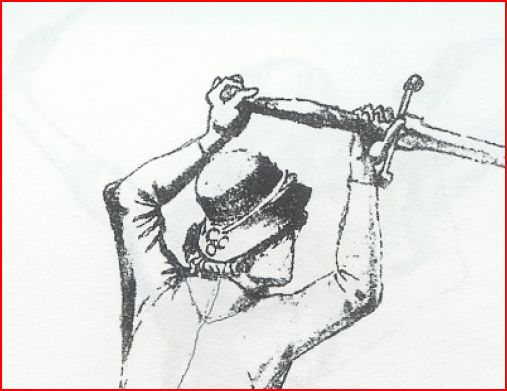
Pushing the thrust.
 Attachment: 48.88 KB Attachment: 48.88 KB
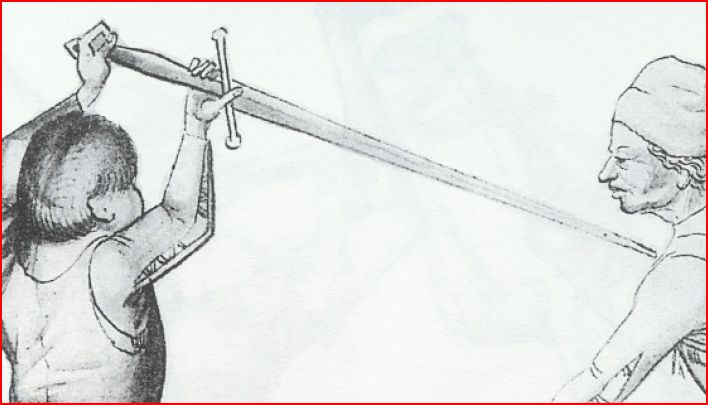
Pushing the thrust.
 Attachment: 40.06 KB Attachment: 40.06 KB
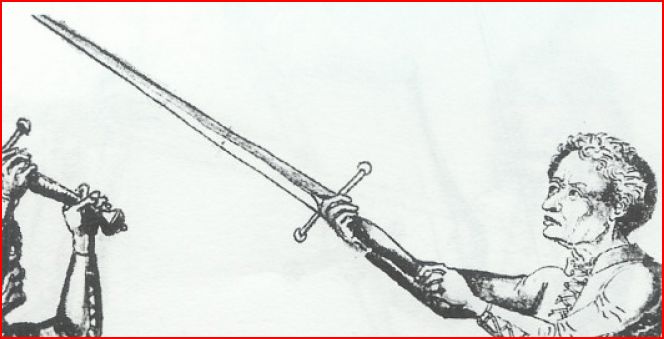
The swordsman on the right is following through an under-cut.
 Attachment: 62.86 KB Attachment: 62.86 KB
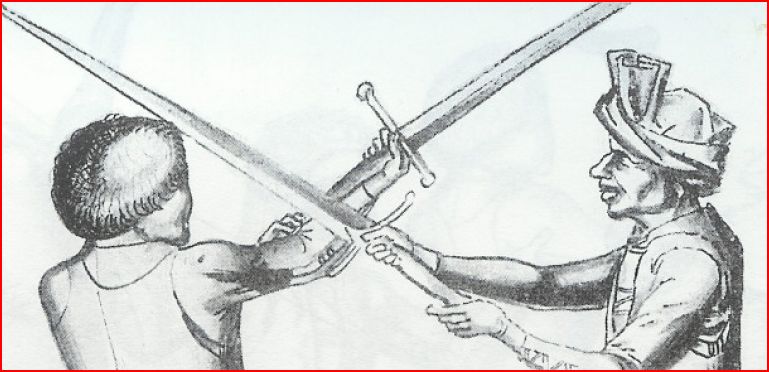
|
|
  |
 |
Greg Coffman

|
 Posted: Thu 12 Apr, 2007 8:53 pm Post subject: Posted: Thu 12 Apr, 2007 8:53 pm Post subject: |
 |
|
Ran, I don't think we are misunderstanding each other, but I do look forward to discussing it with you in person. It is so hard to do online like this. I think we are having a legitimate disagreement and I'm fine with that. I don't think either of us will be able to persuade the other on Sunday and that's fine too. I do enjoy the discussion. I have not heard of even talk within ARMA for a while about gripping the pommel. Maybe I should start a new thread on that forum and see what people think today. Here is a link to an older discussion. It started with a discussion about a place where Doebringer conflicts with later teaching. Hence, here is a time where ARMA member's almost disagree with Doebringer on a separate issue than this. The discussion then turns to the topic at hand.
http://www.thearma.org/forum/viewtopic.php?t=...mp;start=0
I think Doebringer's words are important, but they aren't inspired by God. He is susceptible to typos and mistakes as well as teachings which might only carry the weight of personal preference.
Oh, when gripping the pommel, I do not fight the momentum of the pommel or sword. The sword rotates around my left hand and around the pommel itself. The pommel does not have momentum in this situation. I don't think the discussion should be about balance, like Doebringer makes it out to be. I think it is about grip preference.
Talhoffer does show gripping the pommel alot, even in oberhaus. He is normally considered to be outside the Liechtenauer tradition however it does show that there is precedence for this. Not everyone was taught inside the Liechtenaur tradition, most probably were not in the 15th century. Plenty fighters probably gripped the pommel.
For the word of God is living and active. Sharper than any double-edged sword, it penetrates even to dividing soul and spirit, joints and marrow; it judges the thoughts and attitudes of the heart.
-Hebrews 4:12
|
|
  |
 |
Bill Grandy
myArmoury Team


|
 Posted: Thu 12 Apr, 2007 9:23 pm Post subject: Posted: Thu 12 Apr, 2007 9:23 pm Post subject: |
 |
|
The problem with using Doebringer is that there are a number of things that we don't really understand about the manuscript. I have actually seen more than one translation of it where paragraphs are in different orders, completely changing the meaning of what is said! This is because there are things written in the margins, and we don't exactly know where some of those things belong.
Doebringer is an immensely important resource, and I think it's important not to discount it. But I don't think we can put total faith into it without comparing it to the rest of the Liechtenauer tradition. After all, it's description of alber and pflug don't agree with every other master who followed in Liecthenauer's footsteps. 
Returning back to holding the pommel vs. the grip, Doebringer isn't the only one who didn't do it. Look at Paulus Kal: Most of his plates do not depict the fencers holding the pommel. And what about some of the more bizarre pommel types shown in manuscripts that have spikes and protrusions? I know I wouldn't want to hold those myself. 
Bottom line is that we can't say it is right or wrong to do one or the other based on the historical masters, since clearly those within the same traditions even disagreed. Personally, I don't think it's that important: I've been known to do either grip depending on the sword. Larger hilts I'm more comfortable holding the grip, shorter hilts I'm more comfortable holding the pommel, and in many cases I change this grip in the midst of fencing.
| Quote: |
If not gripping the pommel was important then we would see it taught elsewhere. If it was important to Liechtenauer then we would see it in Ringeck. But we don't. I assume that it is an addition by Doebringer and only his preference. |
Well, to be fair, I don't recall Ringeck saying to grip the pommel, either. In fact, Doebringer is the only source I can think of in the German Medieval arts that even describes what grip a person should use. Everything else is pictoral to my knowledge.
HistoricalHandcrafts.com
-Inspired by History, Crafted by Hand
"For practice is better than artfulness. Your exercise can do well without artfulness, but artfulness is not much good without the exercise.” -anonymous 15th century fencing master, MS 3227a
|
|
   |
 |
Bill Grandy
myArmoury Team


|
 Posted: Thu 12 Apr, 2007 9:29 pm Post subject: Posted: Thu 12 Apr, 2007 9:29 pm Post subject: |
 |
|
| Randall Pleasant wrote: | | For example, with a Zornhau they usually cut to longpoint rather than cutting through longpoint to the Wechsel guard. |
Slight tangent, but I wanted to say that I both agree to an extent and disagree to an extent. I agree with your overall point about playing sword tag (this is actually the phrase I use all the time myself, so I'm glad I'm not the only one who feels this way!  ). However, a zornhau doesn't have to cut all the way to wechsel. Meyer does describe this, and it is important to train to do this... but it is just as important to be able to strike into langen ort. For instance, if I strike at an opponent and he retreats, I may finish in langen ort and travel after immediately. Or if I'm striking against an opponent who goes to oppose my sword, I may have to perform a change through from langen ort. Not to mention that if I'm targeting the head, striking to langen ort will be more than powerful enough against an unarmoured scalp. ). However, a zornhau doesn't have to cut all the way to wechsel. Meyer does describe this, and it is important to train to do this... but it is just as important to be able to strike into langen ort. For instance, if I strike at an opponent and he retreats, I may finish in langen ort and travel after immediately. Or if I'm striking against an opponent who goes to oppose my sword, I may have to perform a change through from langen ort. Not to mention that if I'm targeting the head, striking to langen ort will be more than powerful enough against an unarmoured scalp.
Overall I agree with your main point of cutting through langen ort. I'm just nitpicking about the idea of necessarily going into wechsel, that's all.
HistoricalHandcrafts.com
-Inspired by History, Crafted by Hand
"For practice is better than artfulness. Your exercise can do well without artfulness, but artfulness is not much good without the exercise.” -anonymous 15th century fencing master, MS 3227a
|
|
   |
 |
|
|
You cannot post new topics in this forum
You cannot reply to topics in this forum
You cannot edit your posts in this forum
You cannot delete your posts in this forum
You cannot vote in polls in this forum
You cannot attach files in this forum
You can download files in this forum
|
All contents © Copyright 2003-2025 myArmoury.com — All rights reserved
Discussion forums powered by phpBB © The phpBB Group
Switch to the Basic Low-bandwidth Version of the forum
|

